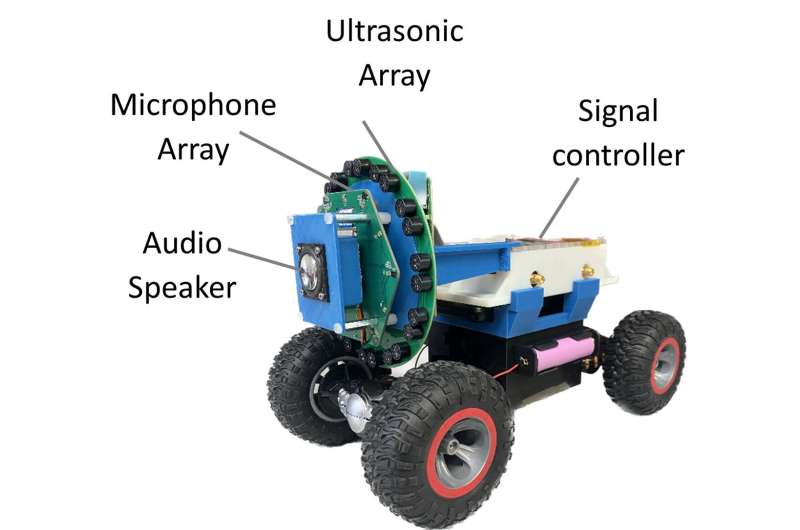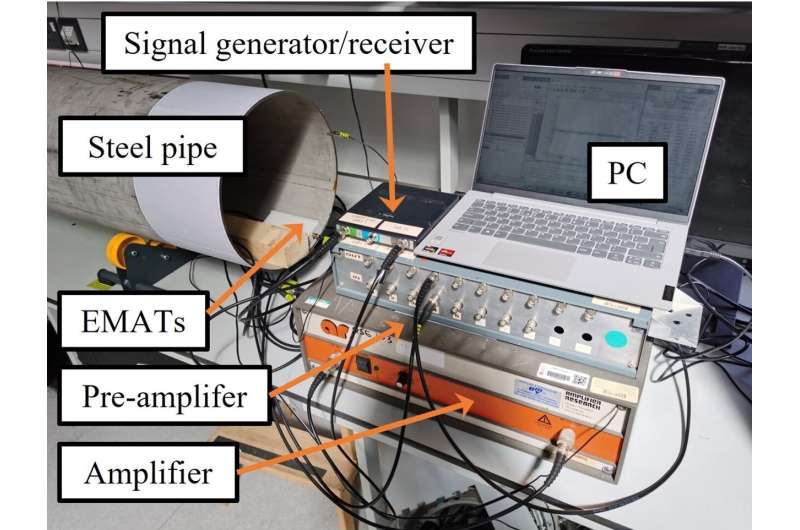This article has been reviewed according to Science X's editorial process and policies. Editors have highlighted the following attributes while ensuring the content's credibility:
fact-checked
trusted source
proofread
Network of robots can successfully monitor pipes using acoustic wave sensors

An inspection design method and procedure by which mobile robots can inspect large pipe structures has been demonstrated with the successful inspection of multiple defects on a three-meter long steel pipe using guided acoustic wave sensors.
The University of Bristol team, led by Professor Bruce Drinkwater and Professor Anthony Croxford, developed approach was used to review a long steel pipe with multiple defects, including circular holes with different sizes, a crack-like defect and pits, through a designed inspection path to achieve 100% detection coverage for a defined reference defect.
In the study they show how they were able to effectively examine large plate-like structures using a network of independent robots, each carrying sensors capable of both sending and receiving guided acoustic waves, working in pulse-echo mode. The paper, "Pipe inspection using guided acoustic wave sensors integrated with mobile robots" was published in NDT and E International.
This approach has the major advantage of minimizing communication between robots, requires no synchronization and raises the possibility of on-board processing to lower data transfer costs and hence reducing overall inspection expenses. The inspection was divided into a defect detection and a defect localization stage.
Lead author Dr. Jie Zhang explained, "There are many robotic systems with integrated ultrasound sensors used for automated inspection of pipelines from their inside to allow the pipeline operator to perform required inspections without stopping the flow of product in the pipeline. However, available systems struggle to cope with varying pipe cross-sections or network complexity, inevitably leading to pipeline disruption during inspection. This makes them suitable for specific inspections of high value assets, such as oil and gas pipelines, but not generally applicable.
"As the cost of mobile robots has reduced over recent years, it is increasingly possible to deploy multiple robots for a large area inspection. We take the existence of small inspection robots as its starting point, and explore how they can be used for generic monitoring of a structure. This requires inspection strategies, methodologies and assessment procedures that can be integrated with the mobile robots for accurate defect detection and localization that is low cost and efficient.
"We investigate this problem by considering a network of robots, each with a single omnidirectional guided acoustic wave transducer. This configuration is considered as it is arguably the simplest, with good potential for integration in a low cost platform."

The methods employed are generally applicable to other related scenarios and allow the impact of any detection or localization method decisions to be quickly quantified. The methods could be used across other materials, pipe geometries, noise levels or guided wave modes, allowing the full range of sensor performance parameters, defects sizes and types and operating modalities to be explored.
Also the techniques can be used to assess the detection and localization performance for specified inspection parameters, for example, predict the minimum detectable defect under a specified probability of detection and probability of false alarm.
The team will now investigate collaboration opportunities with industries to advance current prototypes for actual pipe inspections. The work is part of the Pipebots project.
More information: Jie Zhang et al, Pipe inspection using guided acoustic wave sensors integrated with mobile robots, NDT & E International (2023). DOI: 10.1016/j.ndteint.2023.102929



















